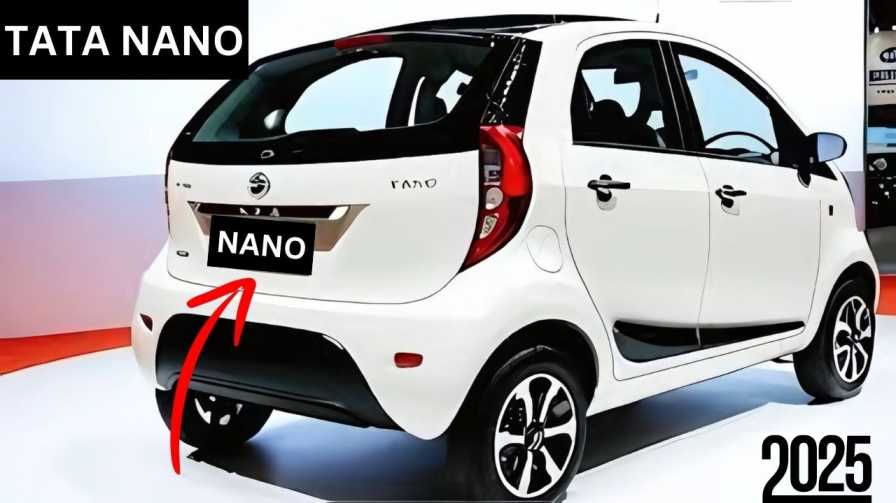In a bold move that is expected to shake up the automotive landscape, Tata Motors is gearing up for the much-anticipated relaunch of the iconic Tata Nano. The Tata Nano, once dubbed the world’s cheapest car, is all set to make a comeback with state-of-the-art technology and a game-changing electric transformation. As the Indian automotive giant looks to adapt to a rapidly evolving market, the reimagined Tata Nano promises to blend affordability, sustainability, and advanced features into one compact package.
First launched in 2009, the Tata Nano garnered global attention for its groundbreaking mission: to offer a safe and affordable four-wheeler alternative to millions of Indian families who had been using motorcycles as their primary mode of transport. Despite a rocky journey, including market challenges and changing consumer preferences, the Tata Nano still symbolizes the innovative spirit of Tata Motors and its visionary approach to mobility.
Now, with the rise of electric vehicles (EVs) and the growing need for affordable, eco-friendly transportation, the Tata Nano is poised to take a second leap into the future. But what makes this potential relaunch so exciting? Let’s dive deep into the details.
Tata Nano’s Vision: A Step Toward Affordable Mobility
A Historic Launch and Visionary Concept
When Ratan Tata unveiled the Tata Nano in 2009, it was nothing short of revolutionary. The idea behind the Nano was simple yet bold: create a family car that would cost less than 100,000 rupees (approximately $1,500 at the time), offering a safer and more comfortable alternative to two-wheelers for millions of Indian families.
At its core, the Tata Nano was designed as a compact, functional car that could change the landscape of personal mobility in India. The intention was clear—to make car ownership accessible to a larger segment of the population who had long been excluded from the automotive market due to high prices. The Nano’s minimalist design, lightweight materials, and cost-effective production methods made it an instant global sensation, positioning Tata Motors as a pioneer in affordable transportation.
The Tata Nano: The Initial Struggles
Despite its innovative design and noble vision, the Tata Nano faced several market challenges. Many consumers associated the car with the label of being a “cheap car”, a perception that hindered its appeal to a wider audience. Further exacerbating the situation were concerns related to safety and build quality, as well as the limited feature set, which was below the evolving expectations of consumers at the time.
As a result, sales of the Nano never reached the heights that Tata Motors had hoped for. The car struggled to gain traction in a market that was increasingly demanding value-added features, advanced technologies, and a premium image. By 2018, Tata Motors officially discontinued the Nano, marking the end of one of the most ambitious experiments in affordable mobility.
The Relaunch: The New Tata Nano as an Electric Car
After a hiatus, Tata Motors is reportedly working on a Tata Nano relaunch that will combine the car’s original affordability with cutting-edge electric vehicle (EV) technology. The goal is to bring the Nano back into the market, this time as a modern, eco-friendly car designed for the urban commuter.
Technological Advancements: Going Electric
The most significant change in the relaunch of the Tata Nano will be its transition to an electric powertrain. The electric Nano is expected to feature a highly efficient electric motor paired with advanced battery technology, ensuring both affordable pricing and sustainable mobility. Here’s what we can expect from the electric Nano:
- Electric Powertrain: A cutting-edge electric motor providing a smooth and silent driving experience.
- Battery Technology: A state-of-the-art lithium-ion battery that offers a practical range of 200-250 kilometers on a single charge.
- Regenerative Braking: A system that recaptures energy during braking, improving overall efficiency.
- Fast Charging: The Nano is expected to feature fast-charging capabilities, enabling users to recharge the car in under an hour at fast charging stations.
- Sustainability Focus: Eco-friendly materials used in manufacturing, along with a zero-emissions profile, making the electric Nano an ideal option for environmentally conscious buyers.
Modern Features and Design Overhaul
Along with an electric makeover, the new Nano will also feature updated design elements to appeal to today’s modern consumer. Tata Motors is reportedly working on an exterior redesign, with a sleek, contemporary look that includes:
- Aerodynamic enhancements to improve efficiency and handling.
- Urban-friendly dimensions that make the car easy to maneuver in congested city streets.
- A range of color options for personalization.
- Sophisticated styling cues that give the Nano a more premium appearance.
Inside, the new Nano is expected to feature:
- Smart digital interfaces and connected car technology, offering users an intuitive experience.
- A minimalist yet functional interior, with ergonomically designed seats.
- An advanced digital instrument cluster, featuring customizable displays for vital vehicle information.
Tata Nano’s Target Audience
The new Tata Nano is expected to cater to a wide range of consumer segments, particularly those seeking an affordable and sustainable mobility solution for urban environments. Some key target audiences include:
- First-Time Car Buyers: Ideal for young professionals and families looking for an affordable transition from motorcycles to four-wheelers.
- Urban Commuters: Individuals who require a compact and efficient vehicle for daily commuting in cities.
- Environmentally Conscious Consumers: Those who prioritize sustainable mobility and electric vehicles with minimal environmental impact.
- Second Car for Families: The Nano can serve as an affordable second car for families in need of an additional vehicle for short trips and errands.
Pricing Strategy and Market Positioning
Tata Motors plans to maintain the Nano’s original philosophy of affordability, but with additional value through modern features and the electric powertrain. The car’s competitive pricing structure will be crucial to its success in the market. Here’s a speculative look at the expected pricing:
| Variant | Expected Price (INR) | Expected Price (USD) |
| Base Model | ₹300,000 – ₹400,000 | $4,000 – $5,500 |
| Mid Variant | ₹400,000 – ₹500,000 | $5,500 – $6,900 |
| Top-End Variant | ₹500,000 – ₹600,000 | $6,900 – $8,200 |
Government Incentives and Financing
To make the electric Nano even more affordable, Tata Motors will likely offer attractive financing options. Moreover, government incentives for electric vehicles in India, including tax rebates, registration fee waivers, and subsidies for charging infrastructure, could further reduce the overall cost of ownership.
Tata Nano: A Game-Changer for Urban Mobility
The relaunch of the Tata Nano isn’t just about bringing back a small car; it’s about reshaping urban mobility. By embracing electric power and offering affordable and environmentally friendly transportation, the new Nano could play a pivotal role in addressing the growing challenges of traffic congestion, air pollution, and sustainable mobility in Indian cities.
With a competitive pricing structure, advanced technology, and eco-friendly features, the Tata Nano could find a renewed audience in urban dwellers, first-time buyers, and eco-conscious consumers. If successful, the Nano could be more than just a car—it could become a symbol of India’s commitment to sustainable, affordable urban transportation.
Conclusion
The Tata Nano’s potential relaunch is an exciting development in the world of affordable electric vehicles. Tata Motors’ commitment to democratizing mobility and making sustainable transportation accessible to all could redefine the way we view urban mobility. With its eco-friendly credentials, modern design, and affordable price tag, the new Nano could yet again capture the imagination of the Indian market and beyond. Only time will tell if the Tata Nano can successfully bridge the gap between affordable personal mobility and cutting-edge electric technology, but the potential for revolutionizing the future of urban transport is immense.





